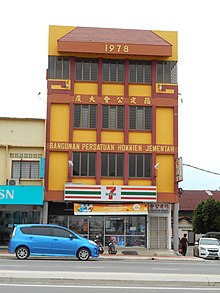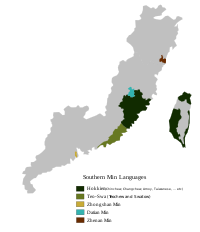lingvo.wikisort.org - Language
Southern Malaysian Hokkien (simplified Chinese: 南马福建话; traditional Chinese: 南馬福建話; pinyin: Nán Mǎ Fújiànhuà; Pe̍h-ōe-jī: Lâm-Má Hok-kiàn-oē) is a local variant of the Min Nan Chinese variety spoken in Central and Southern Peninsular Malaysia (Klang, Melaka, Muar, Tangkak, Segamat, Batu Pahat, Pontian and Johor Bahru). Due to geographical proximity, it is heavily influenced by Singaporean Hokkien.
This article or section possibly contains synthesis of material which does not verifiably mention or relate to the main topic. (January 2011) |
This article needs additional citations for verification. (January 2022) |
| Southern Malaysia Hokkien | |
|---|---|
| 南马福建话 Lâm-Má Hok-kiàn-oē (POJ) | |
| Native to | Southern Malaysia |
| Region | Johor and Malacca |
Language family | Sino-Tibetan
|
| Dialects |
|
| Language codes | |
| ISO 639-3 | – |
| Glottolog | None |
| Linguasphere | 79-AAA-jek |

This dialect is based on Quanzhou-accented varieties of Min Nan, including the Eng Choon (Yongchun) dialect.[1][2] It is markedly distinct from Penang Hokkien and Medan Hokkien, which are based on the Zhangzhou dialect.
Similar to the situation in Singapore, the term Hokkien is generally used by the Chinese in South-east Asia to refer to Min Nan Chinese (闽南语). Southern Malaysian Hokkien is based on the Quanzhou dialect with some influence from the Amoy dialect.
Phonology
This section is based on Eng Choon (Yongchun) Hokkien spoken in Melaka.[3][4]
Vowels
There are eight phonemic vowels:[2]
| Front | Central | Back | |
|---|---|---|---|
| Close | i | ɨ | u |
| Close-mid | e | o | |
| Mid | ə̠ | ||
| Open-mid | ɔ | ||
| Open | a |
Tones
There are seven tones, five of which are long tones and two are checked tones.[1] Like other varieties of Hokkien, these tones also undergo tone sandhi in non-final positions.[1] The tone values (both base tones and sandhi tones) of the long tones are shown below:[5]
| Tone number | Final/base tone | Non-final/sandhi tone |
|---|---|---|
| 1 | ˧ (33) | ˧ (33) |
| 2 | ˨˧ (23) | ˨˩ (21) |
| 3 | ˥˨ (52) | ˧˦ (34) |
| 5 | ˨˩ (21) | ˥˧ (53) |
| 6 | ˨˩ (21) | ˨˩ (21) |
Influences from other languages
Southern Malaysian Hokkien is also subjected to influence from various languages or dialects spoken in Malaysia. This is influenced to a certain degree by the Teochew dialect and is sometimes being regarded to be a combined Hokkien–Teochew speech (especially in Muar, Batu Pahat, Pontian and Johor Bahru).[citation needed]
There are some loanwords from Malay, but they are fewer in number than in Penang Hokkien and do not completely replace the original words in Hokkien.[6] It also has loanwords from English.[citation needed]
Notes
- Chang & Hsieh 2012, p. 38.
- Huang, Chang & Hsieh 2011, p. 914.
- Huang, Chang & Hsieh 2011.
- Chang & Hsieh 2012.
- Chang & Hsieh 2012, p. 43.
- Tan 2001, p. 218.
References
- Chang, Yueh-chin; Hsieh, Feng-fan (2012). "Tonal coarticulation in Malaysian Hokkien: A typological anomaly?". The Linguistic Review. 29 (1): 37–73. doi:10.1515/tlr-2012-0003.
- Huang, Ting; Chang, Yueh-chin; Hsieh, Feng-fan (17–21 August 2011). An Acoustic Analysis of Central Vowels in Malaysian Hokkien (PDF). 17th International Congress of Phonetic Sciences. Hong Kong. pp. 914–917.
- Tan, Chee Beng (2001). "Chinese in Southeast Asia and Identities in Changing Global Context". In Armstrong, M. Jocelyn; Armstrong, R. Warwick; Mulliner, Kent (eds.). Chinese Populations in Contemporary Southeast Asian Societies: Identities, Interdependence and International Influence. London and New York: Routledge. pp. 210–236. ISBN 0-7007-1398-0.
See also
- Hoklo people
- Hokkien culture
- Hokkien architecture
- Written Hokkien
- Hokkien media
- Penang Hokkien
- Singaporean Hokkien
- Taiwanese Hokkien
- Medan Hokkien
- Philippine Hokkien
- Amoy dialect
- Speak Hokkien Campaign
- Holopedia
- Chinese in Malaysia
- Chinese in Singapore
- Chinese in Indonesia
- Chinese in Philippines
Другой контент может иметь иную лицензию. Перед использованием материалов сайта WikiSort.org внимательно изучите правила лицензирования конкретных элементов наполнения сайта.
WikiSort.org - проект по пересортировке и дополнению контента Википедии

